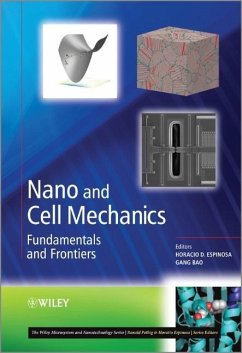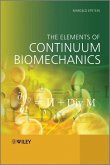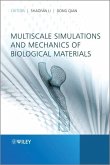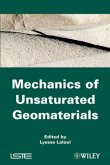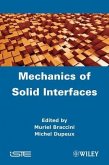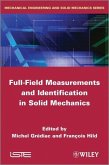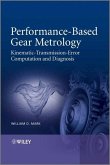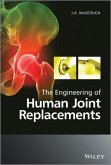- Gebundenes Buch
- Merkliste
- Auf die Merkliste
- Bewerten Bewerten
- Teilen
- Produkt teilen
- Produkterinnerung
- Produkterinnerung
Research in nano and cell mechanics has received much attention from the scientific community as a result of society needs and government initiatives to accelerate developments in materials, manufacturing, electronics, medicine and healthcare, energy, and the environment. Engineers and scientists are currently engaging in increasingly complex scientific problems that require interdisciplinary approaches. In this regard, studies in this field draw from fundamentals in atomistic scale phenomena, biology, statistical and continuum mechanics, and multiscale modeling and experimentation. As a…mehr
Andere Kunden interessierten sich auch für
![The Elements of Continuum Biomechanics The Elements of Continuum Biomechanics]() Marcelo EpsteinThe Elements of Continuum Biomechanics118,99 €
Marcelo EpsteinThe Elements of Continuum Biomechanics118,99 €![Multiscale Simulations and Mechanics of Biological Materials Multiscale Simulations and Mechanics of Biological Materials]() Dong QianMultiscale Simulations and Mechanics of Biological Materials152,99 €
Dong QianMultiscale Simulations and Mechanics of Biological Materials152,99 €![Mechanics of Unsaturated Geomaterials Mechanics of Unsaturated Geomaterials]() Lyesse LalouiMechanics of Unsaturated Geomaterials202,99 €
Lyesse LalouiMechanics of Unsaturated Geomaterials202,99 €![Mechanics of Solid Interfaces Mechanics of Solid Interfaces]() Mechanics of Solid Interfaces178,99 €
Mechanics of Solid Interfaces178,99 €![Full-Field Measurements and Identification in Solid Mechanics Full-Field Measurements and Identification in Solid Mechanics]() Full-Field Measurements and Identification in Solid Mechanics229,99 €
Full-Field Measurements and Identification in Solid Mechanics229,99 €![Performance-Based Gear Metrology Performance-Based Gear Metrology]() William D. MarkPerformance-Based Gear Metrology123,99 €
William D. MarkPerformance-Based Gear Metrology123,99 €![The Engineering of Human Joint Replacements The Engineering of Human Joint Replacements]() Joseph McGeoughThe Engineering of Human Joint Replacements114,99 €
Joseph McGeoughThe Engineering of Human Joint Replacements114,99 €-
-
-
Research in nano and cell mechanics has received much attention from the scientific community as a result of society needs and government initiatives to accelerate developments in materials, manufacturing, electronics, medicine and healthcare, energy, and the environment. Engineers and scientists are currently engaging in increasingly complex scientific problems that require interdisciplinary approaches. In this regard, studies in this field draw from fundamentals in atomistic scale phenomena, biology, statistical and continuum mechanics, and multiscale modeling and experimentation. As a result, contributions in these areas are spread over a large number of specialized journals, which prompted the Editors to assemble this book.
Nano and Cell Mechanics: Fundamentals and Frontiers brings together many of the new developments in the field for the first time, and covers fundamentals and frontiers in mechanics to accelerate developments in nano- and bio-technologies.
Key features:
Provides an overview of recent advances in nano and cell mechanics.
Covers experimental, analytical, and computational tools used to investigate biological and nanoscale phenomena.
Covers fundamentals and frontiers in mechanics to accelerate developments in nano- and bio-technologies.
Presents multiscale-multiphysics modeling and experimentation techniques.
Examines applications in materials, manufacturing, electronics, medicine and healthcare.
Nano and Cell Mechanics: Fundamentals and Frontiers is written by internationally recognized experts in theoretical and applied mechanics, applied physics, chemistry, and biology. It is an invaluable reference for graduate students of nano- and bio-technologies, researchers in academia and industry who are working in nano and cell mechanics, and practitioners who are interested in learning about the latest analysis tools. The book can also serve as a text for graduate courses in theoretical and applied mechanics, mechanical engineering, materials science, and applied physics.
Hinweis: Dieser Artikel kann nur an eine deutsche Lieferadresse ausgeliefert werden.
Nano and Cell Mechanics: Fundamentals and Frontiers brings together many of the new developments in the field for the first time, and covers fundamentals and frontiers in mechanics to accelerate developments in nano- and bio-technologies.
Key features:
Provides an overview of recent advances in nano and cell mechanics.
Covers experimental, analytical, and computational tools used to investigate biological and nanoscale phenomena.
Covers fundamentals and frontiers in mechanics to accelerate developments in nano- and bio-technologies.
Presents multiscale-multiphysics modeling and experimentation techniques.
Examines applications in materials, manufacturing, electronics, medicine and healthcare.
Nano and Cell Mechanics: Fundamentals and Frontiers is written by internationally recognized experts in theoretical and applied mechanics, applied physics, chemistry, and biology. It is an invaluable reference for graduate students of nano- and bio-technologies, researchers in academia and industry who are working in nano and cell mechanics, and practitioners who are interested in learning about the latest analysis tools. The book can also serve as a text for graduate courses in theoretical and applied mechanics, mechanical engineering, materials science, and applied physics.
Hinweis: Dieser Artikel kann nur an eine deutsche Lieferadresse ausgeliefert werden.
Produktdetails
- Produktdetails
- Microsystem and Nanotechnology Series
- Verlag: Wiley & Sons
- 6. Aufl.
- Seitenzahl: 520
- Erscheinungstermin: 29. Januar 2013
- Englisch
- Abmessung: 250mm x 170mm x 29mm
- Gewicht: 916g
- ISBN-13: 9781118460399
- ISBN-10: 1118460391
- Artikelnr.: 36146932
- Herstellerkennzeichnung
- Libri GmbH
- Europaallee 1
- 36244 Bad Hersfeld
- gpsr@libri.de
- Microsystem and Nanotechnology Series
- Verlag: Wiley & Sons
- 6. Aufl.
- Seitenzahl: 520
- Erscheinungstermin: 29. Januar 2013
- Englisch
- Abmessung: 250mm x 170mm x 29mm
- Gewicht: 916g
- ISBN-13: 9781118460399
- ISBN-10: 1118460391
- Artikelnr.: 36146932
- Herstellerkennzeichnung
- Libri GmbH
- Europaallee 1
- 36244 Bad Hersfeld
- gpsr@libri.de
Horacio D. Espinosa, Northwestern University, USA Horacio D. Espinosa is the James and Nancy Farley Professor of Mechanical Engineering at Northwestern University, USA. He is a member of the European Academy of Arts and Sciences, and Fellow of AAM, ASME, and SEM. He served as Editor-in-chief of the Journal of Experimental Mechanics and Associate Editor of the Journal of Applied Mechanics. Currently, he is a co-editor of the Wiley Book Series in Micro and Nanotechnologies and serves in several journal editorial boards. His research interests include biomimetics, size scale electro-mechanical properties of nanomaterials, NEMS, in-situ microscopy testing of nanostructures, and the development of microdevices for tip-based nanofabrication and single cell studies. Gang Bao, Georgia Institute of Technology, USA Gang Bao is Professor of Bioengineering at the Georgia Institute of Technology, USA. His research interests include biomolecular engineering, bionanotechnology, molecular imaging and molecular biomechanics.
About the Editors xiii List of Contributors xv Foreword xix Series Preface xxi Preface xxiii Part One BIOLOGICAL PHENOMENA 1 Cell-Receptor Interactions 3 David Lepzelter and Muhammad Zaman 1.1 Introduction 3 1.2 Mechanics of Integrins 4 1.3 Two-Dimensional Adhesion 7 1.4 Two-Dimensional Motility 9 1.5 Three-Dimensional Adhesion 11 1.6 Three-Dimensional Motility 12 1.7 Apoptosis and Survival Signaling 13 1.8 Cell Differentiation Signaling 13 1.9 Conclusions 14 References 15 2 Regulatory Mechanisms of Kinesin and Myosin Motor Proteins: Inspiration for Improved Control of Nanomachines 19 Sarah Rice 2.1 Introduction 19 2.2 Generalized Mechanism of Cytoskeletal Motors 19 2.3 Switch I: A Controller of Motor Protein and G Protein Activation 21 2.4 Calcium-Binding Regulators of Myosins and Kinesins 23 2.5 Phospho-Regulation of Kinesin and Myosin Motors 262.6 Cooperative Action of Kinesin and Myosin Motors as a "Regulator" 28 2.7 Conclusion 29 References 30 3 Neuromechanics: The Role of Tension in Neuronal Growth and Memory 35 Wylie W. Ahmed, Jagannathan Rajagopalan, Alireza Tofangchi, and Taher A. Saif 3.1 Introduction 35 3.1.1 What is a Neuron? 36 3.1.2 How Does a Neuron Function? 38 3.1.3 How Does a Neuron Grow? 40 3.2 Tension in Neuronal Growth 41 3.2.1 In Vitro Measurements of Tension in Neurons 41 3.2.2 In Vivo Measurements of Tension in Neurons 43 3.2.3 Role of Tension in Structural Development 45 3.3 Tension in Neuron Function 48 3.3.1 Tension Increases Neurotransmission 48 3.3.2 Tension Affects Vesicle Dynamics 48 3.4 Modeling the Mechanical Behavior of Axons 52 3.5 Outlook 58 References 58 Part Two NANOSCALE PHENOMENA 4 Fundamentals of Roughness-Induced Superhydrophobicity 65 Neelesh A. Patankar 4.1 Background and Motivation 65 4.2 Thermodynamic Analysis: Classical Problem (Hydrophobic to Superhydrophobic) 67 4.2.1 Problem Formulation 68 4.2.2 The Cassie-Baxter State 71 4.2.3 Predicting Transition from Cassie-Baxter to Wenzel State 73 4.2.4 The Apparent Contact Angle of the Drop 77 4.2.5 Modeling Hysteresis 79 4.3 Thermodynamic Analysis: Classical Problem (Hydrophilic to Superhydrophobic) 84 4.4 Thermodynamic Analysis: Vapor Stabilization 86 4.5 Applications and Future Challenges 90 Acknowledgments 91 References 91 5 Multiscale Experimental Mechanics of Hierarchical Carbon-Based Materials 95 Horacio D. Espinosa, Tobin Filleter, and Mohammad Naraghi 5.1 Introduction 95 5.2 Multiscale Experimental Tools 97 5.2.1 Revealing Atomic-Level Mechanics: In-Situ TEM Methods 98 5.2.2 Measuring Ultralow Forces: AFM Methods 101 5.2.3 Investigating Shear Interactions: In-Situ SEM/AFM Methods 102 5.2.4 Collective and Local Behavior: Micromechanical Testing Methods 103 5.3 Hierarchical Carbon-Based Materials 106 5.3.1 Weak Shear Interactions between Adjacent Graphitic Layers 106 5.3.2 Cross-linking Adjacent Graphitic Layers 110 5.3.3 Local Mechanical Properties of CNT/Graphene Composites 113 5.3.4 High Volume Fraction CNT Fibers and Composites 115 5.4 Concluding Remarks 120 References 123 6 Mechanics of Nanotwinned Hierarchical Metals 129 Xiaoyan Li and Huajian Gao 6.1 Introduction and Overview 129 6.1.1 Nanotwinned Materials 130 6.1.2 Numerical Modeling of Nanotwinned Metals 132 6.2 Microstructural Characterization and Mechanical Properties of Nanotwinned Materials 134 6.2.1 Structure of Coherent Twin Boundary 134 6.2.2 Microstructures of Nanotwinned Materials 135 6.2.3 Mechanical and Physical Properties of Nanotwinned Metals 137 6.3 Deformation Mechanisms in Nanotwinned Metals 145 6.3.1 Interaction between Dislocations and Twin Boundaries 146 6.3.2 Strengthening and Softening Mechanisms in Nanotwinned Metals 147 6.3.3 Fracture of Nanotwinned Copper 155 6.4 Concluding Remarks 156 References 157 7 Size-Dependent Strength in Single-Crystalline Metallic Nanostructures 163 Julia R. Greer 7.1 Introduction 163 7.2 Background 164 7.2.1 Experimental Foundation 164 7.2.2 Models 167 7.3 Sample Fabrication 170 7.3.1 FIB Approach 170 7.3.2 Directional Solidification and Etching 172 7.3.3 Templated Electroplating 173 7.3.4 Nanoimprinting 173 7.3.5 Vapor-Liquid-Solid Growth 174 7.3.6 Nanowire Growth 175 7.4 Uniaxial Deformation Experiments 175 7.4.1 Nanoindenter-Based Systems (Ex Situ) 176 7.4.2 In-Situ Systems 176 7.5 Discussion and Outlook on Size-Dependent Strength in Single-Crystalline Metals 178 7.5.1 Cubic Crystals 178 7.5.2 Non-Cubic Single Crystals 183 7.6 Conclusions and Outlook 184 References 185 Part Three EXPERIMENTATION 8 In-Situ TEM Electromechanical Testing of Nanowires and Nanotubes 193 Horacio D. Espinosa, Rodrigo A. Bernal, and Tobin Filleter 8.1 Introduction 193 8.1.1 Relevance of Mechanical and Electromechanical Testing for One-Dimensional Nanostructures 194 8.1.2 Mechanical and Electromechanical Characterization of Nanostructures: The Need for In-Situ TEM 196 8.2 In-Situ TEM Experimental Methods 197 8.2.1 Overview of TEM Specimen Holders 199 8.2.2 Methods for Mechanical and Electromechanical Testing of Nanowires and Nanotubes 200 8.2.3 Sample Preparation for TEM of One-Dimensional Nanostructures 208 8.3 Capabilities of In-Situ TEM Applied to One-Dimensional Nanostructures 212 8.3.1 HRTEM 212 8.3.2 Diffraction 216 8.3.3 Analytical Techniques 217 8.3.4 In-Situ Specimen Modification 218 8.4 Summary and Outlook 220 Acknowledgments 221 References 221 9 Engineering Nano-Probes for Live-Cell Imaging of Gene Expression 227 Gang Bao, Brian Wile, and Andrew Tsourkas 9.1 Introduction 227 9.2 Molecular Probes for RNA Detection 229 9.2.1 Fluorescent Linear Probes 229 9.2.2 Linear FRET Probes 232 9.2.3 Quenched Auto-ligation Probes 233 9.2.4 Molecular Beacons 234 9.2.5 Dual-FRET Molecular Beacons 236 9.2.6 Fluorescent Protein-Based Probes 237 9.3 Probe Design, Imaging, and Biological Issues 239 9.3.1 Specificity of Molecular Beacons 239 9.3.2 Fluorophores, Quenchers, and Signal-to-Background 241 9.3.3 Target Accessibility 242 9.4 Delivery of Molecular Beacons 244 9.4.1 Microinjection 245 9.4.2 Cationic Transfection Agents 245 9.4.3 Electroporation 245 9.4.4 Chemical Permeabilization 246 9.4.5 Cell-Penetrating Peptide 246 9.5 Engineering Challenges and Future Directions 248 Acknowledgments 249 References 249 10 Towards High-Throughput Cell Mechanics Assays for Research and Clinical Applications 255 David R. Myers, Daniel A. Fletcher, and Wilbur A. Lam 10.1 Cell Mechanics Overview 255 10.1.1 Cell Cytoskeleton and Cell-Sensing Overview 256 10.1.2 Forces Applied by Cells 259 10.1.3 Cell Responses to Force and Environment 260 10.1.4 General Principles of Combined Mechanical and Biological Measurements 261 10.2 Bulk Assays 262 10.2.1 Microfiltration 262 10.2.2 Rheometry 264 10.2.3 Ektacytometry 266 10.2.4 Parallel-Plate Flow Chambers 267 10.3 Single-Cell Techniques 268 10.3.1 Micropipette Aspiration 268 10.3.2 Atomic Force Microscopy 270 10.3.3 Microplate Stretcher 272 10.3.4 Optical Tweezers 273 10.4 Existing High-Throughput Cell Mechanical-Based Assays 274 10.4.1 Optical Stretchers 274 10.4.2 Traction Force Microscopy via Bead-Embedded Gels 275 10.4.3 Traction Force Microscopy via Micropost Arrays 275 10.4.4 Substrate Stretching Assays 277 10.4.5 Magnetic Twisting Cytometry 277 10.4.6 Microfluidic Pore and Deformation Assays 278 10.5 Cell Mechanical Properties and Diseases 280 References 284 11 Microfabricated Technologies for Cell Mechanics Studies 293 Sri Ram K. Vedula, Man C. Leong, and Chwee T. Lim 11.1 Introduction 293 11.2 Microfabrication Techniques 294 11.2.1 Photolithography and Soft Lithography 294 11.2.2 Microphotopatterning (
PP) 297 11.3 Applications to Cell Mechanics 298 11.3.1 Micropatterned Substrates 298 11.3.2 Micropillared Substrates 301 11.3.3 Microfluidic Devices 304 11.4 Conclusions 307 References 307 Part Four MODELING 12 Atomistic Reaction Pathway Sampling: The Nudged Elastic BandMethod and Nanomechanics Applications 313 Ting Zhu, Ju Li, and Sidney Yip 12.1 Introduction 313 12.1.1 Reaction Pathway Sampling in Nanomechanics 314 12.1.2 Extending the Time Scale in Atomistic Simulation 314 12.1.3 Transition-State Theory 315 12.2 The NEB Method for Stress-Driven Problems 315 12.2.1 The NEB method 315 12.2.2 The Free-End NEB Method 317 12.2.3 Stress-Dependent Activation Energy and Activation Volume 320 12.2.4 Activation Entropy and Meyer-Neldel Compensation Rule 322 12.3 Nanomechanics Case Studies 324 12.3.1 Crack Tip Dislocation Emission 324 12.3.2 Stress-Mediated Chemical Reactions 326 12.3.3 Bridging Modeling with Experiment 327 12.3.4 Temperature and Strain-Rate Dependence of Dislocation Nucleation 329 12.3.5 Size and Loading Effects on Fracture 330 12.4 A Perspective on Microstructure Evolution at Long Times 332 12.4.1 Sampling TSP Trajectories 333 12.4.2 Nanomechanics in Problems of Materials Ageing 334 References 336 13 Mechanics of Curvilinear Electronics 339 Shuodao Wang, Jianliang Xiao, Jizhou Song, Yonggang Huang, and John A. Rogers 13.1 Introduction 339 13.2 Deformation of Elastomeric Transfer Elements during Wrapping Processes 342 13.2.1 Strain Distribution in Stretched Elastomeric Transfer Elements 342 13.2.2 Deformed Shape of Elastomeric Transfer Elements 344 13.3 Buckling of Interconnect Bridges 347 13.4 Maximum Strain in the Circuit Mesh 351 13.5 Concluding Remarks 355 Acknowledgments 355 References 355 14 Single-Molecule Pulling: Phenomenology and Interpretation 359 Ignacio Franco, Mark A. Ratner, and George C. Schatz 14.1 Introduction 359 14.2 Force-Extension Behavior of Single Molecules 360 14.3 Single-Molecule Thermodynamics 364 14.3.1 Free Energy Profile of the Molecule Plus Cantilever 365 14.3.2 Extracting the Molecular Potential of Mean Force
(
) 366 14.3.3 Estimating Force-Extension Behavior from
(
) 369 14.4 Modeling Single-Molecule Pulling Using Molecular Dynamics 370 14.4.1 Basic Computational Setup 370 14.4.2 Modeling Strategies 371 14.4.3 Examples 373 14.5 Interpretation of Pulling Phenomenology 376 14.5.1 Basic Structure of the Molecular Potential of Mean Force 377 14.5.2 Mechanical Instability 378 14.5.3 Dynamical Bistability 381 14.6 Summary 384 Acknowledgments 385 References 385 15 Modeling and Simulation of Hierarchical Protein Materials 389 Tristan Giesa, Graham Bratzel, and Markus J. Buehler 15.1 Introduction 389 15.2 Computational and Theoretical Tools 391 15.2.1 Molecular Simulation from Chemistry Upwards 391 15.2.2 Mesoscale Methods for Modeling Larger Length and Time Scales 392 15.2.3 Mathematical Approaches to Biomateriomics 394 15.3 Case Studies 400 15.3.1 Atomistic and Mesoscale Protein Folding and Deformation in Spider Silk 400 15.3.2 Coarse-Grained Modeling of Actin Filaments 402 15.3.3 Category Theoretical Abstraction of a Protein Material and Analogy to an Office Network 403 15.4 Discussion and Conclusion 406 Acknowledgments 406 References 406 16 Geometric Models of Protein Secondary-Structure Formation 411 Hendrik Hansen-Goos and Seth Lichter 16.1 Introduction 411 16.2 Hydrophobic Effect 412 16.2.1 Variable Hydrogen-Bond Strength 415 16.3 Prior Numerical and Coarse-Grained Models 415 16.4 Geometry-Based Modeling: The Tube Model 416 16.4.1 Motivation 416 16.4.2 Impenetrable Tube Models 417 16.4.3 Including Finite-Sized Particles Surrounding the Protein 419 16.4.4 Models Using Real Protein Structure 421 16.5 Morphometric Approach to Solvation Effects 422 16.5.1 Hadwiger's Theorem 422 16.5.2 Applications 424 16.6 Discussion, Conclusions, Future Work 429 16.6.1 Results 429 16.6.2 Discussion and Speculations 430 Acknowledgments 433 References 433 17 Multiscale Modeling for the Vascular Transport of Nanoparticles 437 Shaolie S. Hossain, Adrian M. Kopacz, Yongjie Zhang, Sei-Young Lee, Tae-Rin Lee, Mauro Ferrari, Thomas J.R. Hughes, Wing Kam Liu, and Paolo Decuzzi 17.1 Introduction 437 17.2 Modeling the Dynamics of NPs in the Macrocirculation 438 17.2.1 The 3D Reconstruction of the Patient-Specific Vasculature 439 17.2.2 Modeling the Vascular Flow and Wall Adhesion of NPs 440 17.2.3 Modeling NP Transport across the Arterial Wall and Drug Release 440 17.3 Modeling the NP Dynamics in the Microcirculation 448 17.3.1 Semi-analytical Models for the NP Transport 449 17.3.2 An IFEM for NP and Cell Transport 452 17.4 Conclusions 456 Acknowledgments 456 References 457 Index 461
PP) 297 11.3 Applications to Cell Mechanics 298 11.3.1 Micropatterned Substrates 298 11.3.2 Micropillared Substrates 301 11.3.3 Microfluidic Devices 304 11.4 Conclusions 307 References 307 Part Four MODELING 12 Atomistic Reaction Pathway Sampling: The Nudged Elastic BandMethod and Nanomechanics Applications 313 Ting Zhu, Ju Li, and Sidney Yip 12.1 Introduction 313 12.1.1 Reaction Pathway Sampling in Nanomechanics 314 12.1.2 Extending the Time Scale in Atomistic Simulation 314 12.1.3 Transition-State Theory 315 12.2 The NEB Method for Stress-Driven Problems 315 12.2.1 The NEB method 315 12.2.2 The Free-End NEB Method 317 12.2.3 Stress-Dependent Activation Energy and Activation Volume 320 12.2.4 Activation Entropy and Meyer-Neldel Compensation Rule 322 12.3 Nanomechanics Case Studies 324 12.3.1 Crack Tip Dislocation Emission 324 12.3.2 Stress-Mediated Chemical Reactions 326 12.3.3 Bridging Modeling with Experiment 327 12.3.4 Temperature and Strain-Rate Dependence of Dislocation Nucleation 329 12.3.5 Size and Loading Effects on Fracture 330 12.4 A Perspective on Microstructure Evolution at Long Times 332 12.4.1 Sampling TSP Trajectories 333 12.4.2 Nanomechanics in Problems of Materials Ageing 334 References 336 13 Mechanics of Curvilinear Electronics 339 Shuodao Wang, Jianliang Xiao, Jizhou Song, Yonggang Huang, and John A. Rogers 13.1 Introduction 339 13.2 Deformation of Elastomeric Transfer Elements during Wrapping Processes 342 13.2.1 Strain Distribution in Stretched Elastomeric Transfer Elements 342 13.2.2 Deformed Shape of Elastomeric Transfer Elements 344 13.3 Buckling of Interconnect Bridges 347 13.4 Maximum Strain in the Circuit Mesh 351 13.5 Concluding Remarks 355 Acknowledgments 355 References 355 14 Single-Molecule Pulling: Phenomenology and Interpretation 359 Ignacio Franco, Mark A. Ratner, and George C. Schatz 14.1 Introduction 359 14.2 Force-Extension Behavior of Single Molecules 360 14.3 Single-Molecule Thermodynamics 364 14.3.1 Free Energy Profile of the Molecule Plus Cantilever 365 14.3.2 Extracting the Molecular Potential of Mean Force
(
) 366 14.3.3 Estimating Force-Extension Behavior from
(
) 369 14.4 Modeling Single-Molecule Pulling Using Molecular Dynamics 370 14.4.1 Basic Computational Setup 370 14.4.2 Modeling Strategies 371 14.4.3 Examples 373 14.5 Interpretation of Pulling Phenomenology 376 14.5.1 Basic Structure of the Molecular Potential of Mean Force 377 14.5.2 Mechanical Instability 378 14.5.3 Dynamical Bistability 381 14.6 Summary 384 Acknowledgments 385 References 385 15 Modeling and Simulation of Hierarchical Protein Materials 389 Tristan Giesa, Graham Bratzel, and Markus J. Buehler 15.1 Introduction 389 15.2 Computational and Theoretical Tools 391 15.2.1 Molecular Simulation from Chemistry Upwards 391 15.2.2 Mesoscale Methods for Modeling Larger Length and Time Scales 392 15.2.3 Mathematical Approaches to Biomateriomics 394 15.3 Case Studies 400 15.3.1 Atomistic and Mesoscale Protein Folding and Deformation in Spider Silk 400 15.3.2 Coarse-Grained Modeling of Actin Filaments 402 15.3.3 Category Theoretical Abstraction of a Protein Material and Analogy to an Office Network 403 15.4 Discussion and Conclusion 406 Acknowledgments 406 References 406 16 Geometric Models of Protein Secondary-Structure Formation 411 Hendrik Hansen-Goos and Seth Lichter 16.1 Introduction 411 16.2 Hydrophobic Effect 412 16.2.1 Variable Hydrogen-Bond Strength 415 16.3 Prior Numerical and Coarse-Grained Models 415 16.4 Geometry-Based Modeling: The Tube Model 416 16.4.1 Motivation 416 16.4.2 Impenetrable Tube Models 417 16.4.3 Including Finite-Sized Particles Surrounding the Protein 419 16.4.4 Models Using Real Protein Structure 421 16.5 Morphometric Approach to Solvation Effects 422 16.5.1 Hadwiger's Theorem 422 16.5.2 Applications 424 16.6 Discussion, Conclusions, Future Work 429 16.6.1 Results 429 16.6.2 Discussion and Speculations 430 Acknowledgments 433 References 433 17 Multiscale Modeling for the Vascular Transport of Nanoparticles 437 Shaolie S. Hossain, Adrian M. Kopacz, Yongjie Zhang, Sei-Young Lee, Tae-Rin Lee, Mauro Ferrari, Thomas J.R. Hughes, Wing Kam Liu, and Paolo Decuzzi 17.1 Introduction 437 17.2 Modeling the Dynamics of NPs in the Macrocirculation 438 17.2.1 The 3D Reconstruction of the Patient-Specific Vasculature 439 17.2.2 Modeling the Vascular Flow and Wall Adhesion of NPs 440 17.2.3 Modeling NP Transport across the Arterial Wall and Drug Release 440 17.3 Modeling the NP Dynamics in the Microcirculation 448 17.3.1 Semi-analytical Models for the NP Transport 449 17.3.2 An IFEM for NP and Cell Transport 452 17.4 Conclusions 456 Acknowledgments 456 References 457 Index 461
About the Editors xiii List of Contributors xv Foreword xix Series Preface xxi Preface xxiii Part One BIOLOGICAL PHENOMENA 1 Cell-Receptor Interactions 3 David Lepzelter and Muhammad Zaman 1.1 Introduction 3 1.2 Mechanics of Integrins 4 1.3 Two-Dimensional Adhesion 7 1.4 Two-Dimensional Motility 9 1.5 Three-Dimensional Adhesion 11 1.6 Three-Dimensional Motility 12 1.7 Apoptosis and Survival Signaling 13 1.8 Cell Differentiation Signaling 13 1.9 Conclusions 14 References 15 2 Regulatory Mechanisms of Kinesin and Myosin Motor Proteins: Inspiration for Improved Control of Nanomachines 19 Sarah Rice 2.1 Introduction 19 2.2 Generalized Mechanism of Cytoskeletal Motors 19 2.3 Switch I: A Controller of Motor Protein and G Protein Activation 21 2.4 Calcium-Binding Regulators of Myosins and Kinesins 23 2.5 Phospho-Regulation of Kinesin and Myosin Motors 262.6 Cooperative Action of Kinesin and Myosin Motors as a "Regulator" 28 2.7 Conclusion 29 References 30 3 Neuromechanics: The Role of Tension in Neuronal Growth and Memory 35 Wylie W. Ahmed, Jagannathan Rajagopalan, Alireza Tofangchi, and Taher A. Saif 3.1 Introduction 35 3.1.1 What is a Neuron? 36 3.1.2 How Does a Neuron Function? 38 3.1.3 How Does a Neuron Grow? 40 3.2 Tension in Neuronal Growth 41 3.2.1 In Vitro Measurements of Tension in Neurons 41 3.2.2 In Vivo Measurements of Tension in Neurons 43 3.2.3 Role of Tension in Structural Development 45 3.3 Tension in Neuron Function 48 3.3.1 Tension Increases Neurotransmission 48 3.3.2 Tension Affects Vesicle Dynamics 48 3.4 Modeling the Mechanical Behavior of Axons 52 3.5 Outlook 58 References 58 Part Two NANOSCALE PHENOMENA 4 Fundamentals of Roughness-Induced Superhydrophobicity 65 Neelesh A. Patankar 4.1 Background and Motivation 65 4.2 Thermodynamic Analysis: Classical Problem (Hydrophobic to Superhydrophobic) 67 4.2.1 Problem Formulation 68 4.2.2 The Cassie-Baxter State 71 4.2.3 Predicting Transition from Cassie-Baxter to Wenzel State 73 4.2.4 The Apparent Contact Angle of the Drop 77 4.2.5 Modeling Hysteresis 79 4.3 Thermodynamic Analysis: Classical Problem (Hydrophilic to Superhydrophobic) 84 4.4 Thermodynamic Analysis: Vapor Stabilization 86 4.5 Applications and Future Challenges 90 Acknowledgments 91 References 91 5 Multiscale Experimental Mechanics of Hierarchical Carbon-Based Materials 95 Horacio D. Espinosa, Tobin Filleter, and Mohammad Naraghi 5.1 Introduction 95 5.2 Multiscale Experimental Tools 97 5.2.1 Revealing Atomic-Level Mechanics: In-Situ TEM Methods 98 5.2.2 Measuring Ultralow Forces: AFM Methods 101 5.2.3 Investigating Shear Interactions: In-Situ SEM/AFM Methods 102 5.2.4 Collective and Local Behavior: Micromechanical Testing Methods 103 5.3 Hierarchical Carbon-Based Materials 106 5.3.1 Weak Shear Interactions between Adjacent Graphitic Layers 106 5.3.2 Cross-linking Adjacent Graphitic Layers 110 5.3.3 Local Mechanical Properties of CNT/Graphene Composites 113 5.3.4 High Volume Fraction CNT Fibers and Composites 115 5.4 Concluding Remarks 120 References 123 6 Mechanics of Nanotwinned Hierarchical Metals 129 Xiaoyan Li and Huajian Gao 6.1 Introduction and Overview 129 6.1.1 Nanotwinned Materials 130 6.1.2 Numerical Modeling of Nanotwinned Metals 132 6.2 Microstructural Characterization and Mechanical Properties of Nanotwinned Materials 134 6.2.1 Structure of Coherent Twin Boundary 134 6.2.2 Microstructures of Nanotwinned Materials 135 6.2.3 Mechanical and Physical Properties of Nanotwinned Metals 137 6.3 Deformation Mechanisms in Nanotwinned Metals 145 6.3.1 Interaction between Dislocations and Twin Boundaries 146 6.3.2 Strengthening and Softening Mechanisms in Nanotwinned Metals 147 6.3.3 Fracture of Nanotwinned Copper 155 6.4 Concluding Remarks 156 References 157 7 Size-Dependent Strength in Single-Crystalline Metallic Nanostructures 163 Julia R. Greer 7.1 Introduction 163 7.2 Background 164 7.2.1 Experimental Foundation 164 7.2.2 Models 167 7.3 Sample Fabrication 170 7.3.1 FIB Approach 170 7.3.2 Directional Solidification and Etching 172 7.3.3 Templated Electroplating 173 7.3.4 Nanoimprinting 173 7.3.5 Vapor-Liquid-Solid Growth 174 7.3.6 Nanowire Growth 175 7.4 Uniaxial Deformation Experiments 175 7.4.1 Nanoindenter-Based Systems (Ex Situ) 176 7.4.2 In-Situ Systems 176 7.5 Discussion and Outlook on Size-Dependent Strength in Single-Crystalline Metals 178 7.5.1 Cubic Crystals 178 7.5.2 Non-Cubic Single Crystals 183 7.6 Conclusions and Outlook 184 References 185 Part Three EXPERIMENTATION 8 In-Situ TEM Electromechanical Testing of Nanowires and Nanotubes 193 Horacio D. Espinosa, Rodrigo A. Bernal, and Tobin Filleter 8.1 Introduction 193 8.1.1 Relevance of Mechanical and Electromechanical Testing for One-Dimensional Nanostructures 194 8.1.2 Mechanical and Electromechanical Characterization of Nanostructures: The Need for In-Situ TEM 196 8.2 In-Situ TEM Experimental Methods 197 8.2.1 Overview of TEM Specimen Holders 199 8.2.2 Methods for Mechanical and Electromechanical Testing of Nanowires and Nanotubes 200 8.2.3 Sample Preparation for TEM of One-Dimensional Nanostructures 208 8.3 Capabilities of In-Situ TEM Applied to One-Dimensional Nanostructures 212 8.3.1 HRTEM 212 8.3.2 Diffraction 216 8.3.3 Analytical Techniques 217 8.3.4 In-Situ Specimen Modification 218 8.4 Summary and Outlook 220 Acknowledgments 221 References 221 9 Engineering Nano-Probes for Live-Cell Imaging of Gene Expression 227 Gang Bao, Brian Wile, and Andrew Tsourkas 9.1 Introduction 227 9.2 Molecular Probes for RNA Detection 229 9.2.1 Fluorescent Linear Probes 229 9.2.2 Linear FRET Probes 232 9.2.3 Quenched Auto-ligation Probes 233 9.2.4 Molecular Beacons 234 9.2.5 Dual-FRET Molecular Beacons 236 9.2.6 Fluorescent Protein-Based Probes 237 9.3 Probe Design, Imaging, and Biological Issues 239 9.3.1 Specificity of Molecular Beacons 239 9.3.2 Fluorophores, Quenchers, and Signal-to-Background 241 9.3.3 Target Accessibility 242 9.4 Delivery of Molecular Beacons 244 9.4.1 Microinjection 245 9.4.2 Cationic Transfection Agents 245 9.4.3 Electroporation 245 9.4.4 Chemical Permeabilization 246 9.4.5 Cell-Penetrating Peptide 246 9.5 Engineering Challenges and Future Directions 248 Acknowledgments 249 References 249 10 Towards High-Throughput Cell Mechanics Assays for Research and Clinical Applications 255 David R. Myers, Daniel A. Fletcher, and Wilbur A. Lam 10.1 Cell Mechanics Overview 255 10.1.1 Cell Cytoskeleton and Cell-Sensing Overview 256 10.1.2 Forces Applied by Cells 259 10.1.3 Cell Responses to Force and Environment 260 10.1.4 General Principles of Combined Mechanical and Biological Measurements 261 10.2 Bulk Assays 262 10.2.1 Microfiltration 262 10.2.2 Rheometry 264 10.2.3 Ektacytometry 266 10.2.4 Parallel-Plate Flow Chambers 267 10.3 Single-Cell Techniques 268 10.3.1 Micropipette Aspiration 268 10.3.2 Atomic Force Microscopy 270 10.3.3 Microplate Stretcher 272 10.3.4 Optical Tweezers 273 10.4 Existing High-Throughput Cell Mechanical-Based Assays 274 10.4.1 Optical Stretchers 274 10.4.2 Traction Force Microscopy via Bead-Embedded Gels 275 10.4.3 Traction Force Microscopy via Micropost Arrays 275 10.4.4 Substrate Stretching Assays 277 10.4.5 Magnetic Twisting Cytometry 277 10.4.6 Microfluidic Pore and Deformation Assays 278 10.5 Cell Mechanical Properties and Diseases 280 References 284 11 Microfabricated Technologies for Cell Mechanics Studies 293 Sri Ram K. Vedula, Man C. Leong, and Chwee T. Lim 11.1 Introduction 293 11.2 Microfabrication Techniques 294 11.2.1 Photolithography and Soft Lithography 294 11.2.2 Microphotopatterning (
PP) 297 11.3 Applications to Cell Mechanics 298 11.3.1 Micropatterned Substrates 298 11.3.2 Micropillared Substrates 301 11.3.3 Microfluidic Devices 304 11.4 Conclusions 307 References 307 Part Four MODELING 12 Atomistic Reaction Pathway Sampling: The Nudged Elastic BandMethod and Nanomechanics Applications 313 Ting Zhu, Ju Li, and Sidney Yip 12.1 Introduction 313 12.1.1 Reaction Pathway Sampling in Nanomechanics 314 12.1.2 Extending the Time Scale in Atomistic Simulation 314 12.1.3 Transition-State Theory 315 12.2 The NEB Method for Stress-Driven Problems 315 12.2.1 The NEB method 315 12.2.2 The Free-End NEB Method 317 12.2.3 Stress-Dependent Activation Energy and Activation Volume 320 12.2.4 Activation Entropy and Meyer-Neldel Compensation Rule 322 12.3 Nanomechanics Case Studies 324 12.3.1 Crack Tip Dislocation Emission 324 12.3.2 Stress-Mediated Chemical Reactions 326 12.3.3 Bridging Modeling with Experiment 327 12.3.4 Temperature and Strain-Rate Dependence of Dislocation Nucleation 329 12.3.5 Size and Loading Effects on Fracture 330 12.4 A Perspective on Microstructure Evolution at Long Times 332 12.4.1 Sampling TSP Trajectories 333 12.4.2 Nanomechanics in Problems of Materials Ageing 334 References 336 13 Mechanics of Curvilinear Electronics 339 Shuodao Wang, Jianliang Xiao, Jizhou Song, Yonggang Huang, and John A. Rogers 13.1 Introduction 339 13.2 Deformation of Elastomeric Transfer Elements during Wrapping Processes 342 13.2.1 Strain Distribution in Stretched Elastomeric Transfer Elements 342 13.2.2 Deformed Shape of Elastomeric Transfer Elements 344 13.3 Buckling of Interconnect Bridges 347 13.4 Maximum Strain in the Circuit Mesh 351 13.5 Concluding Remarks 355 Acknowledgments 355 References 355 14 Single-Molecule Pulling: Phenomenology and Interpretation 359 Ignacio Franco, Mark A. Ratner, and George C. Schatz 14.1 Introduction 359 14.2 Force-Extension Behavior of Single Molecules 360 14.3 Single-Molecule Thermodynamics 364 14.3.1 Free Energy Profile of the Molecule Plus Cantilever 365 14.3.2 Extracting the Molecular Potential of Mean Force
(
) 366 14.3.3 Estimating Force-Extension Behavior from
(
) 369 14.4 Modeling Single-Molecule Pulling Using Molecular Dynamics 370 14.4.1 Basic Computational Setup 370 14.4.2 Modeling Strategies 371 14.4.3 Examples 373 14.5 Interpretation of Pulling Phenomenology 376 14.5.1 Basic Structure of the Molecular Potential of Mean Force 377 14.5.2 Mechanical Instability 378 14.5.3 Dynamical Bistability 381 14.6 Summary 384 Acknowledgments 385 References 385 15 Modeling and Simulation of Hierarchical Protein Materials 389 Tristan Giesa, Graham Bratzel, and Markus J. Buehler 15.1 Introduction 389 15.2 Computational and Theoretical Tools 391 15.2.1 Molecular Simulation from Chemistry Upwards 391 15.2.2 Mesoscale Methods for Modeling Larger Length and Time Scales 392 15.2.3 Mathematical Approaches to Biomateriomics 394 15.3 Case Studies 400 15.3.1 Atomistic and Mesoscale Protein Folding and Deformation in Spider Silk 400 15.3.2 Coarse-Grained Modeling of Actin Filaments 402 15.3.3 Category Theoretical Abstraction of a Protein Material and Analogy to an Office Network 403 15.4 Discussion and Conclusion 406 Acknowledgments 406 References 406 16 Geometric Models of Protein Secondary-Structure Formation 411 Hendrik Hansen-Goos and Seth Lichter 16.1 Introduction 411 16.2 Hydrophobic Effect 412 16.2.1 Variable Hydrogen-Bond Strength 415 16.3 Prior Numerical and Coarse-Grained Models 415 16.4 Geometry-Based Modeling: The Tube Model 416 16.4.1 Motivation 416 16.4.2 Impenetrable Tube Models 417 16.4.3 Including Finite-Sized Particles Surrounding the Protein 419 16.4.4 Models Using Real Protein Structure 421 16.5 Morphometric Approach to Solvation Effects 422 16.5.1 Hadwiger's Theorem 422 16.5.2 Applications 424 16.6 Discussion, Conclusions, Future Work 429 16.6.1 Results 429 16.6.2 Discussion and Speculations 430 Acknowledgments 433 References 433 17 Multiscale Modeling for the Vascular Transport of Nanoparticles 437 Shaolie S. Hossain, Adrian M. Kopacz, Yongjie Zhang, Sei-Young Lee, Tae-Rin Lee, Mauro Ferrari, Thomas J.R. Hughes, Wing Kam Liu, and Paolo Decuzzi 17.1 Introduction 437 17.2 Modeling the Dynamics of NPs in the Macrocirculation 438 17.2.1 The 3D Reconstruction of the Patient-Specific Vasculature 439 17.2.2 Modeling the Vascular Flow and Wall Adhesion of NPs 440 17.2.3 Modeling NP Transport across the Arterial Wall and Drug Release 440 17.3 Modeling the NP Dynamics in the Microcirculation 448 17.3.1 Semi-analytical Models for the NP Transport 449 17.3.2 An IFEM for NP and Cell Transport 452 17.4 Conclusions 456 Acknowledgments 456 References 457 Index 461
PP) 297 11.3 Applications to Cell Mechanics 298 11.3.1 Micropatterned Substrates 298 11.3.2 Micropillared Substrates 301 11.3.3 Microfluidic Devices 304 11.4 Conclusions 307 References 307 Part Four MODELING 12 Atomistic Reaction Pathway Sampling: The Nudged Elastic BandMethod and Nanomechanics Applications 313 Ting Zhu, Ju Li, and Sidney Yip 12.1 Introduction 313 12.1.1 Reaction Pathway Sampling in Nanomechanics 314 12.1.2 Extending the Time Scale in Atomistic Simulation 314 12.1.3 Transition-State Theory 315 12.2 The NEB Method for Stress-Driven Problems 315 12.2.1 The NEB method 315 12.2.2 The Free-End NEB Method 317 12.2.3 Stress-Dependent Activation Energy and Activation Volume 320 12.2.4 Activation Entropy and Meyer-Neldel Compensation Rule 322 12.3 Nanomechanics Case Studies 324 12.3.1 Crack Tip Dislocation Emission 324 12.3.2 Stress-Mediated Chemical Reactions 326 12.3.3 Bridging Modeling with Experiment 327 12.3.4 Temperature and Strain-Rate Dependence of Dislocation Nucleation 329 12.3.5 Size and Loading Effects on Fracture 330 12.4 A Perspective on Microstructure Evolution at Long Times 332 12.4.1 Sampling TSP Trajectories 333 12.4.2 Nanomechanics in Problems of Materials Ageing 334 References 336 13 Mechanics of Curvilinear Electronics 339 Shuodao Wang, Jianliang Xiao, Jizhou Song, Yonggang Huang, and John A. Rogers 13.1 Introduction 339 13.2 Deformation of Elastomeric Transfer Elements during Wrapping Processes 342 13.2.1 Strain Distribution in Stretched Elastomeric Transfer Elements 342 13.2.2 Deformed Shape of Elastomeric Transfer Elements 344 13.3 Buckling of Interconnect Bridges 347 13.4 Maximum Strain in the Circuit Mesh 351 13.5 Concluding Remarks 355 Acknowledgments 355 References 355 14 Single-Molecule Pulling: Phenomenology and Interpretation 359 Ignacio Franco, Mark A. Ratner, and George C. Schatz 14.1 Introduction 359 14.2 Force-Extension Behavior of Single Molecules 360 14.3 Single-Molecule Thermodynamics 364 14.3.1 Free Energy Profile of the Molecule Plus Cantilever 365 14.3.2 Extracting the Molecular Potential of Mean Force
(
) 366 14.3.3 Estimating Force-Extension Behavior from
(
) 369 14.4 Modeling Single-Molecule Pulling Using Molecular Dynamics 370 14.4.1 Basic Computational Setup 370 14.4.2 Modeling Strategies 371 14.4.3 Examples 373 14.5 Interpretation of Pulling Phenomenology 376 14.5.1 Basic Structure of the Molecular Potential of Mean Force 377 14.5.2 Mechanical Instability 378 14.5.3 Dynamical Bistability 381 14.6 Summary 384 Acknowledgments 385 References 385 15 Modeling and Simulation of Hierarchical Protein Materials 389 Tristan Giesa, Graham Bratzel, and Markus J. Buehler 15.1 Introduction 389 15.2 Computational and Theoretical Tools 391 15.2.1 Molecular Simulation from Chemistry Upwards 391 15.2.2 Mesoscale Methods for Modeling Larger Length and Time Scales 392 15.2.3 Mathematical Approaches to Biomateriomics 394 15.3 Case Studies 400 15.3.1 Atomistic and Mesoscale Protein Folding and Deformation in Spider Silk 400 15.3.2 Coarse-Grained Modeling of Actin Filaments 402 15.3.3 Category Theoretical Abstraction of a Protein Material and Analogy to an Office Network 403 15.4 Discussion and Conclusion 406 Acknowledgments 406 References 406 16 Geometric Models of Protein Secondary-Structure Formation 411 Hendrik Hansen-Goos and Seth Lichter 16.1 Introduction 411 16.2 Hydrophobic Effect 412 16.2.1 Variable Hydrogen-Bond Strength 415 16.3 Prior Numerical and Coarse-Grained Models 415 16.4 Geometry-Based Modeling: The Tube Model 416 16.4.1 Motivation 416 16.4.2 Impenetrable Tube Models 417 16.4.3 Including Finite-Sized Particles Surrounding the Protein 419 16.4.4 Models Using Real Protein Structure 421 16.5 Morphometric Approach to Solvation Effects 422 16.5.1 Hadwiger's Theorem 422 16.5.2 Applications 424 16.6 Discussion, Conclusions, Future Work 429 16.6.1 Results 429 16.6.2 Discussion and Speculations 430 Acknowledgments 433 References 433 17 Multiscale Modeling for the Vascular Transport of Nanoparticles 437 Shaolie S. Hossain, Adrian M. Kopacz, Yongjie Zhang, Sei-Young Lee, Tae-Rin Lee, Mauro Ferrari, Thomas J.R. Hughes, Wing Kam Liu, and Paolo Decuzzi 17.1 Introduction 437 17.2 Modeling the Dynamics of NPs in the Macrocirculation 438 17.2.1 The 3D Reconstruction of the Patient-Specific Vasculature 439 17.2.2 Modeling the Vascular Flow and Wall Adhesion of NPs 440 17.2.3 Modeling NP Transport across the Arterial Wall and Drug Release 440 17.3 Modeling the NP Dynamics in the Microcirculation 448 17.3.1 Semi-analytical Models for the NP Transport 449 17.3.2 An IFEM for NP and Cell Transport 452 17.4 Conclusions 456 Acknowledgments 456 References 457 Index 461

